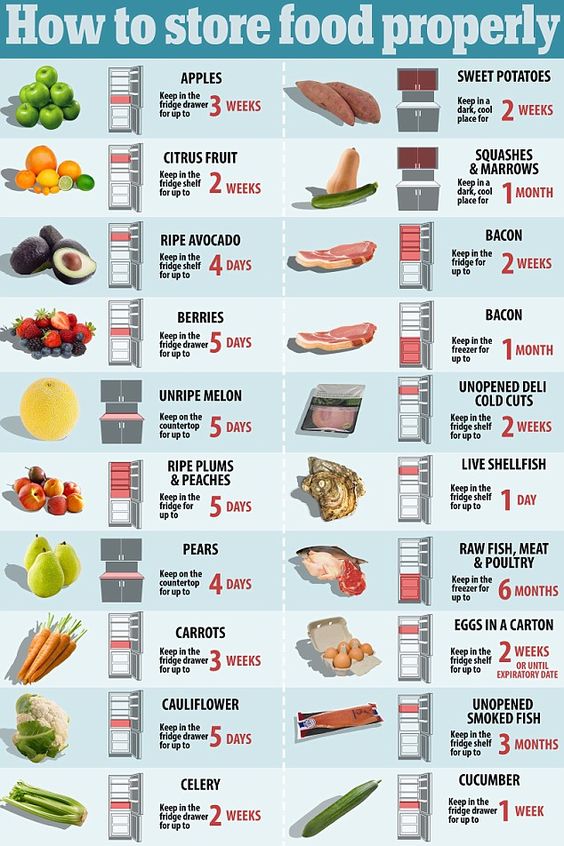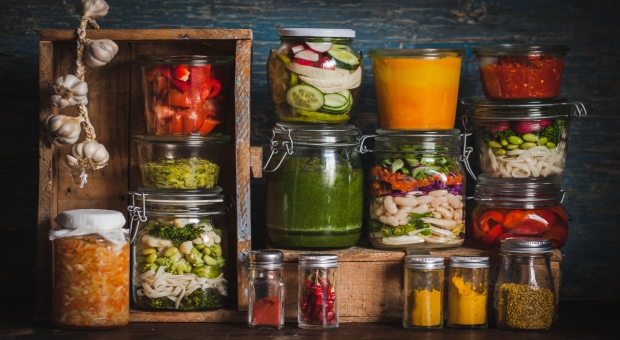For every serious prepper, food storage remains a constant concern.
Regardless of the event you are preparing for, storing food allows you to survive for extended periods of time and will give you the peace of mind required to concentrate on using your survival skills. The fear of hunger is something that always lingers above us, no matter how full our pantry is.
You can’t help yourself thinking about this, and it’s all due to our genetic memory developed throughout human history. If you think about it, food was often scarce, and starvation was always a problem for past generation. Storing food properly was one of the first skills we humans learned.
History showed us that every major civilization on this planet was built on a surplus of food. It was through food storage techniques that people had the opportunity to come together and build kingdoms. Those who managed to store food for the winter would get to see another spring.
Even in our civilized world, food shortages still take the lives of less fortunate people. Being able to store food is a skill useful not only for preppers and survivalists but for every human in general. If you have a full pantry, you will have good morale, and you can face everything life throws at you.
Starting with food storage
Just like every project, you should start small and grow over time. Since it may be your first time doing this, there’s no point in going all in and risk of losing it all. Start with a few bags of rice or some extra cans of vegetables and any other foods your family eats. You can do so every time you go shopping, and it doesn’t have to be a pressing concern.
Most, if not all, supermarkets have modern foods that store really well, and you can find a large variety at good prices. Once you buy some extra for your pantry, develop the habit of writing on the package the date you bought them. This will help you down the road with the proper cycling of your foods.
Cycling through foods
This becomes mandatory for every food storage tactic, and you don’t just buy the food to store it away and forget about it. It’s not there just to help you when the end of the world comes, and it can be used under various circumstances (unemployment, temporary shortage, etc.).
Once you fill up your pantry, you will need to make sure nothing goes to waste. To cycle through your food, you need to eat from the oldest of your stored goods and replace what you used. To keep your stocks fresh and complete just follow the rule: “First in, first out.”
Even your dry food needs to be properly inventoried, and you need to cycle through it annually. Rather than using digital timesheets, I suggest you go with the classical pen an paper. These will never let you down in case the power goes down.
Below are the most common and a few unusual methods of food storage.
 Drying
Drying
When organizing a survival pantry, the first foods on every list are usually grains and beans. Most people buy their food already dried and prepare for storage while others like to prepare it themselves. Regardless of the method you prefer, keeping such goods dry can often become a challenge. It becomes even more of a problem if you don’t have enough storage space in your home.
Choosing a place outside of the home to store your dried goods require constant supervision of the place since dampness, insects, and rodents can ruin your entire food storage in a few hours. It requires a lot of work to keep it safe, to make sure the food will still be edible when you need it the most.
You can store grains, beans, and legumes in bulk, but you will need to invest in some proper containers. Also, desiccants and oxygen absorbers are required to keep the food dry and remove any moisture buildup. Double bag your food stores and secure the covers to the cans. You can use plastic containers to store smaller amounts of foods (up to 10 pounds).
Now, when it comes to the drying process itself, you can dry pretty much any food you can think of. Some preppers use a professional or commercial food dehydrator while others still use the old method of drying food in the oven. You can dry vegetables, fruits, and meats if you follow the basic rules of food drying and you can make it all in the comfort of your home
Blanching and Canning
These methods are used today as they were when your grandparents and great-grandparents handled all the food storage needs. They will provide food diversity required during long-term survival.
Blanching is a technique that works best in combination with freezing. It basically involves submerging the food in boiling water (to start the cooking process) and then removing it from the hot water and immediately submerging the food in cold water to stop the changes. Bagging and freezing should be done straight away to preserve the fresh nature and aroma of the foods. Blanching is mostly done for vegetables, and it makes cooking much easier.
The canning method involves sealing cooked food while hot to kill all bacteria that might spoil it. As a main rule, canned foods should be stored at room temperature away from sunlight.
There is a lot of literature on canning, and I won’t go into details about it. Just keep in mind that with a little bit of practice, meats, fruits, and vegetables can be canned and stored for several years. Making jams, jellies, and pickles are a family hobby for some and a tradition developed over many years. Canning also helps you save money since once you consume the foods, you can reuse the canning jars for a new batch. Nothing goes to waste in terms of packaging.
Pickling, Brining and Salting
The food engineers of the past have experienced with natural and artificial preservatives to help prolong the life of foods. While many prefer to use the artificial options these days like powdered and liquid chemicals, some still focus on the old methods of preserving food with vinegar, salt, and spices. It’s the proper way to go since you can learn how to make vinegar at home and you can store salt in large quantities at reasonable costs, and dry your own herbs and spices.
Pickling
This food preservation method was vastly used in ancient times, and it’s still used today by many homesteaders. The technique involves using the combination of salt and vinegar to preserve fruits, vegetables, and meat.
Brining
The brine is a solution made of salt, sugar, and cold water.
This preservation method is somehow similar to marinating, and it is mainly used for meat and poultry. For this technique to work properly, you will need to soak the food in brine for six to twelve hours to prevent the growth of food microbes. In general, the soaking duration will vary depending on the size of the meat.
Salting
This food preservation technique is perhaps one of the oldest, and it works because the salt draws all the moisture of the meat, which consequently prevents the growth of bacteria and other microbes. It is still a method used primarily in cold regions.
If you would like to use this method, you will need to make sure the meat is not kept in open air after salting and cover it with a lid or plastic. As you can imagine, foods preserved using this method will taste quite salty, and it may not be for everyone.
Smoking
In our country, smoking is used for cooking and flavoring, and it has become a form of art in many states. However, it is also an ancient method of preserving food for long periods of time. In the past, the technique was used mostly for meat and fish, but nowadays people are using it also for vegetables.
Smoking works because the intense heat from burning materials (like wood or pellets) kills bacteria and other food microorganisms, and the process is rather simple.
The technique involves heating the meat above a fire (fueled by hardwood) and the temperature is kept between 43°F and 159° F. The smoking time depends on the type and amount of meat you are using.
People from my network have started using a vacuum sealer to preserve the smoked goods for extended periods of time.
Preservation in oil and honey
These are ancient food preservation techniques that helped our ancestors build reliable stocks of food. They are not entirely common to the modern prepper, although these methods are very effective. I recommend you look into it.
The process is rather simple, but it requires paying attention and a little bit of practice. You will need to cover the meat, fruits, and vegetables with honey or oil to prevent the growth of bacteria.
Honey has sugar and osmotic value that will draw out moisture from the food. In a similar way, oil kills pathogens and blocks the intake (flow) of oxygen to the food. Even if some microbes are present on the food, they will not last due to the lack of oxygen.
I’ve eaten meat preserved in honey when I traveled to Africa, and I had the chance to see and hear from our guests how they prepared the meat for storage. They would first grill or smoke the meat and allow it to cool down. They would prepare jars or small wooden barrels by adding a layer of honey in the containers. After that, they would add the pieces of meat until the honey starts to rise up, reaching the top of the jar. Remember the meat has to be completely submerged.
As I’ve understood from them, this can also be done with raw meat, but it requires to be drained of blood and washed properly. Lightly grilling or smoking the meat is much safer. The meat should last forever as long as you keep good hygiene.
A few tips for long-term storage
When you start storing food, you will soon notice that such a project will take quite some space and time, and it will increase over time. The space for food storage is affected by factors such as number of family members, planned period (one year, two or more) and most importantly, your budget.
You will need to have a dedicated space for this project, and once you manage to acquire it, you will need to keep in mind the following:
- The storage space needs to be dry to avoid problems caused by mold and rot
- A food storage area should have a constant temperature, especially if you plan on storing lots of home-canned foods
- The food storage space should be protected against rodents and other pests. Rather than using chemicals, try looking into natural methods to keep pests at bay
- The food storage space needs to be easily accessible and conveniently located. You must be able to get to it in time, and it must be secured from looters.
- Everyone from your family needs to know what’s stored, how the food should be cycled and what it can be used for
- Always check your food and test various items at random to see if the food is still edible
Concluding
No matter what you look at things and whatever people or experts will tell you, food becomes your number one concern if you are a preparedness like-minded individual. Having a food stash makes sense not only for when SHTF, but for every situation that may occur.
More than half of Americans have less than a week’s worth of food in their home, and you probably don’t want to be one of them. It doesn’t matter if you live in a remote location or an apartment in the big city. You should always have food stored that will help you survive when there’s no outside help.













































































With all the various difficulties involved in creating a food storage including; oxygen, vitamins, a balanced diet , volume etc.
Can anyone give some reasons why not to just store lots of varied M.R.E.s ?
Only drawback I can foresee is the need of water.
They are compact , tastey ,long life , cheap.
I still have lots of tinned fruit ,grains,meat, etc.
But at least 70% of my stores are M.R.E.
There’s nothing wrong with storing MREs; however, you must be sure that everyone in the family can eat them. This becomes mandatory if you have young and old members depending on those MREs.
To be on the safe side, when you plan on buying a significant supply of MREs, you should do a taste test with your family. You will find your family can tolerate them. You might be able to do so, but others would have trouble keeping them down.
Also, the 24 hours test is a must, and it’s complementary to the taste test. You need to wait for your digestive system to express its opinion. Your gut will tell you if you made the right choice or not.
Sample different MREs from different manufacturers before you stock up. I hope my input helps.
Best regards,
Bob
Thanks for the reply Bob
I do a MRE meal roughly once a week.
I will add meat, rice or veg etc to make one MRE sufficient for three or four.
This is to ensure it tastes good and gives no after effects.
☆I’ve recently added lots of protein powder meals,creatin, smoothie blends, powdered veggies etc to my stock.
They take very little space and weight almost nothing.
One thing I remember from MREs , The biscuits can plug you up solid !!
For this reason or any hic-up I also have a good amount of constipation or diarrhoea remedies
Be careful about MREs, Jeff. They are heavy and bulky, the taste is repulsive to many, and they are sometimes Near Expiration when sold. There are simply better choices out there – I buy large quantities from Mountain House – They are Freeze-Dried, light and compact, very tasty, and reasonably priced. Look around before you spend a lot.
A Well written article, Bob. I will keep a copy for reference. Please – Keep Doing what you are doing so well !
Thanks, Bill! Will do.
I once heard that if you apply a light coat of mineral oil to eggs they will store for six months in the frig. That didn’t sound right,so I tested it.By golly it works!
After six months there were no floaters and they looked and tasted just fine.
Sometimes I think we get caught up in the “Best By/Use By “ hoopla to our detriment. Canned goods either home or store bought, probably give give us the best value per dollar in the pantry. Foods remain fit for consumption far past the date on the can.
Sadly of the six food banks in our area only one will accept donations if the can has expired by even one day.
Yes, it works quite well. Also, I recommend you try three other methods (I’ve written about them in the past on my website) that work even better.
You can use salt, water glass (sodium silicate) and solution of lime (this has a +90% success rate) to preserve eggs long-term. You can experiment with these three methods on a small batch and you won’t be disappointed.
Thank you for the honey and oil meat preservation tip. I’d never heard it and I like it. Would serve two purposes, you’d have some sweetness available if ran out of sugar and protein from the meat.
Actually, our host used the honey from the meat on some crepes (I don’t recall how they called them) of some sort, even tough they had a bland taste. They spread the honey on them and served them with tea. Goes without saying that the overall taste was highly improved after adding the honey. 🙂
So you’re right, you have both sugars and proteins in one sitting and you can improvise with honey as you seem fit.
Hi Bob,
Just a question so that I’m sure of what I’m doing. If I understand the post about the meat/honey…You can grill a steak or hamburger, pour some honey in a jar, add the meat until it’s cov ered with honey and then seal the jar.??
Am I correct?
I have read of using grease instead of oil, specifically cooking sausage patties and storing them layered with grease on the bottom and each patty separated and covered by grease with a layer of grease on top. That way, only as much meat as was wanted could be removed, with the rest remaining covered by grease. From all accounts, this worked indefinitely, or at least until all the meat was used.
I’m told that mylar bags should be used insaving items such as rice and beans. Why not just put these items in no 10 012 cans, or sealable plastic tubs? Of course, those pads that
take up oxygen would be used.
For years you have been telling me to prepare for a disaster. I thought here in California it would be an earthquake. I didn’t anticipate an unseen virus the would confine me to my home for months. I was well supplied with regular grocery store items that I regularly buy, so I know I like them. Canned fruit is yuck, but my fruit trees provided plenty I still haven’t needed to buy toilet paper or paper towels (I use rags). For protein, I am pretty much down to rice and beans or lentils, Spam, tuna, canned salmon, and canned hash. I have electricity and water, so life is easy. I ran out of kitty litter, so the cat needs to go outside. Everything else has been fine. I could go for another couple of months. Thank you for all the years of teaching me.
Eggs will keep in their cartons easily for three months…they may float a little if boiled but they are perfectly fine and good to eat. As for bacon, it will keep indefinitely in the freezer as long as it is in its vacuum package. In the hurricanes of 2004, I lost everything in my freezer due to power outages. I didn’t open the door and I let all the stuff in there refreeze . Then we got hit with another hurricane in a few months; again no power. I had buried most everything after it was re-frozen the first time but had left the bacon thinking I could give it to the dogs some time. Finally after being thawed and refrozen two times, I decided to totally empty my freezer and cooked the bacon. It smelled just fine when I fried it, sampled it and it was perfectly good. Yes, I did eat it! Also, canned goods will last up to 5 or 6 years as long as the vacuum in the can is good! Oh, and please don’t jump on me for giving my dogs bacon. I normally wouldn’t do that but when things are going south you do what is necessary to survive! Ignore those use by dates. They are just a racket to get you to dump perfectly good food and buy more! Waste not – want not!